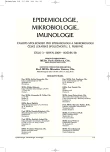Serological Characteristics of Hantaviruses from Clinical Specimens Analyzed in 1998-2008 in the Department of Virology, Public Health Institute, Ostrava
Authors:
H. Zelená; J. Januška
Authors‘ workplace:
Virologické oddělení, Národní referenční laboratoř ČR pro arboviry, Zdravotní ústav se sídlem v Ostravě
Published in:
Epidemiol. Mikrobiol. Imunol. 58, 2009, č. 3, s. 115-120
Overview
In 1998 – 2008, serum samples from 464 patients, predominantly residents of the Moravia-Silesian Region, were examined in the Department of Virology, Public Health Institute in Ostrava, using Enzyme-Linked ImmunoSorbent Assay (ELISA) for the detection of specific anti-hantavirus antibodies. Seropositivity was ascertained in 41 persons (8.8 %). More patients tested seropositive against Hantaan virus (24, i.e. 58.5 %) than against Puumala virus (13, i.e. 31.7 %). Four persons were reactive against both antigens. Clinical symptoms corresponding to hantavirus infection were observed in 19 seropositive patients. Fifteen of them had antibodies reactive with Hantaan virus antigen (cross-reactive with anti-Dobrava virus), 3 patients had antibodies against Puumala virus and 1 patient had both types of antibodies. Clinical data on the other seropositive persons were lacking. The higher rate of Dobrava virus infections in the Moravian-Silesian Region seems to be associated, among others, with the geographic distribution of striped field mouse (Apodemus agrarius) which is the main reservoir of Dobrava virus in Central Europe.
Key words:
hantavirus – Dobrava virus – Puumala virus – haemorrhagic fever with renal syndrome – nephropathia epidemica – Apodemus agrarius.
Sources
1. Anděra, M. Mapa rozšíření Apodemus agrarius v ČR. BioLib 2008 [http://www.biolib.cz/cz/taxonmap/id26/]
2. Bryja, J., Řehák, Z. Další doklady současné expanze areálu myšice temnopásé (Apodemus agrarius) na Moravě, Lynx (Praha), n.s., 2002, 33, 69-77.
3. Dušek, J., Pejčoch, M., Kolský, A., Seman, T. et al. Mild course of Puumala nephropathy in children in an area with sporadic occurrence Hantavirus infection. Pediatr Nephrol, 2006, 21, 12, 1889-1892.
4. Gresikova, M., Rajcani, J., Sekeyova, M., Brummer-Korvenkontio, M. et al. Haemorrhagic fever virus with renal syndrome in small rodents in Czechoslovakia. Acta Virol, 1984, 28, 5, 416-421.
5. Heyman, P., Vaheri, A., ENIVD members. Situation of hantavirus infections and haemorrhagic fever with renal syndrome in European countries as of December 2006. Eurosurveillance, 2008, 13, 28, 1-6.
6. Kobzík, J., Daneš, L. Laboratorně potvrzené případy hemoragické horečky s ledvinovým syndromem v letech 1989-1990 na Břeclavsku. Epidemiol Mikrobiol Imunol, 1992, 41, 2, 65-68.
7. Pejčoch, M., Heroldová, M., Zejda, J., Treml, F. et al. Nálezy hantavirového antigenu u hlodavců v České republice. Epidemiol Mikrobiol Imunol, 2003, 52, 1, 18-24.
8. Pejčoch, M., Kříž, B. Hantaviruses in the Czech Republic. Emerg Infect Dis, 2003, 9, 6, 756-757.
9. Pejčoch, M., Kříž, B. Prevalence of antibodies against hantaviruses among adult population of the Czech republic. Cent Eur J Publ Health, 2003, 11, 3, 169-172.
10. Pejčoch, M., Kříž, B. Hantaviry a jimi vyvolaná onemocnění v České republice. Prakt lékař, 2007, 87, 9, 545-549.
11. Sibold, C., Ulrich, R., Labuda, M., Lundkvist, A. et al. Dobrava Hantavirus Causes Hemorrhagic Fever with Renal Syndrome in Central Europe and is Carried by two Different Apodemus Mice Species. J Med Virol, 2001, 63, 2, 158-167.
12. Sjolander, K. B., Lundkvist, A. Dobrava virus infection: serological diagnosis and cross-reactions to other hantaviruses. J Virol Meth, 1999, 80, 2, 137-143.
13. Vacková, M., Jebavý, L., Beran, J., Douda, P. Febrilní stavy způsobené hantaviry. Prakt lék., 2002, 82, 2, 84-86.
14. Vapalahti, O., Mustonen, J., Lundkvist, A., Henttonen, H. et al. Hantavirus infections in Europe. Lancet Infect Dis, 2003, 3, 10, 653-661.
15. Weidmann, M., Schmidt, P., Vackova, M., Krivanec, P. et al. Identification of Genetic Evidence for Dobrava Virus Spillover in Rodents by Nested Reverse Transcription (RT)-PCR and TaqMan RT-PCR. J Clin Microbiol, 2005, 43, 2, 808-812.
Labels
Hygiene and epidemiology Medical virology Clinical microbiologyArticle was published in
Epidemiology, Microbiology, Immunology

2009 Issue 3
Most read in this issue
- Use of PCR in Diagnosis of Enteroviral Infections
- Apitherapy – the Role of Honey in the Chronic Wound Healing Process
- Waterborne Diseases Outbreaks in the Czech Republic, 1995-2005
- Serological Characteristics of Hantaviruses from Clinical Specimens Analyzed in 1998-2008 in the Department of Virology, Public Health Institute, Ostrava
